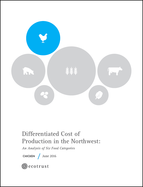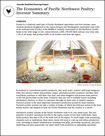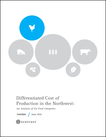Pastured Chicken |
Research Chapters
|
|
Overview
Poultry is a relatively small part of Pacific Northwest agriculture and food systems; meat chickens (broilers) slaughtered in Oregon and Washington represented only 0.6% of the national total. Poultry of the Middle is virtually nonexistent in the Northwest: broiler farms in the wide range of size classes between 2,000–199,999 birds sold per year total only 1.2% of all farms, and produce 0.8% of all broilers sold from the region. In contrast to conventional poultry producers, who work under contract with large integrator firms that advance inputs and purchase output, alternative poultry producers purchase their own chicks, purchase or mill their own feed, and often slaughter and process some portion of the full-grown birds on the farm. Producers may also sell to multiple buyers including wholesalers, retailers, or direct to customers through on-farm sales or farmer’s markets. Pastured poultry is the most important alternative production system for meat chickens. Pastured poultry systems can take a variety of forms, of which the field pen system is the most widely known and adopted in both the Pacific Northwest and the country as a whole. Alternative poultry systems in the Pacific Northwest tend to be very small-scale. The vast majority of poultry operations (93.5%) in the region consist of less than 2,000 birds; these farms produce less than 0.2% of the birds sold in the region. To reach larger scale purchasing channels such as institutions, these micro-farms will need to scale up and reduce production costs. Investing in shared infrastructure including feed mills, processing operations, and joint marketing and sales approaches can assist small-scale producers in expanding operations. Supply Drivers
Demand Drivers
Opportunities
For more detail on the economics of pastured chicken production in the Pacific Northwest download Production Analysis: Chicken from the right sidebar. |
Downloadable FilesBelow are combined and individual files related to chicken production and infrastructure opportunities in WA and OR. To stay informed about next steps from this research please share appropriate information below.
Combined FileIndividual Files
|











